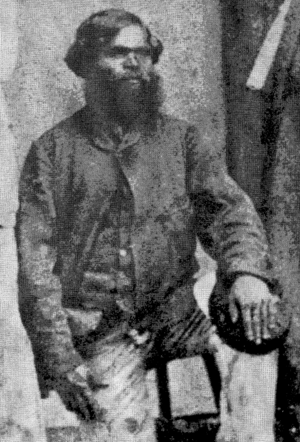Tommy Windich facts for kids
Tommy Windich (born around 1840 – died about 20 February 1876) was an Aboriginal Australian who was a key member of many exploring trips in Western Australia during the 1860s and 1870s. He was known for his amazing tracking skills and his deep knowledge of the land.
Contents
Early Life and Skills
Tommy Windich, also known as Windiitj, was born around 1840. His birthplace was near Mount Stirling in Western Australia. We don't know much about his childhood. However, his skills suggest he had a traditional upbringing. He was excellent at tracking and knew several Aboriginal languages. He also learned skills like horseriding and marksmanship. These skills came from his contact with European settlers.
Working with the Police
By the early 1860s, Windich started working for the police in York. He was a "native assistant," which meant he helped with tracking. His main jobs were to find people who had escaped, like those who had run away from prison. He also tracked lost horses.
In 1863, he joined Cowits, another Aboriginal assistant policeman. They went with Henry Maxwell Lefroy on an expedition east of York. This was one of his first big trips.
In 1865, Windich used his tracking skills to help catch a prison escapee named Joseph Johns. This person later became the famous outlaw Moondyne Joe. In early 1866, he helped capture three Aboriginal men. They had attacked a farmer. One of the men fought back and injured Windich's arm with a spear. This event showed everyone how good Windich was at tracking. It also proved he was a reliable and helpful member of any team. After this, many people wanted him for their expeditions.
Later in 1866, Windich and Cowits joined Constable Edwards. They were part of a police trip that went east. On this trip, they found oil.
Exploring Western Australia
Around 1866, Windich was stationed in Beverley. He continued his police work there. But he also went on many exploring trips.
Hunt's Third Expedition
Windich's next big exploration was with Charles Hunt. Cowits also joined this trip. Their goal was to explore the area east of the Hampton Plains. However, there was unexpected dry weather. This meant there wasn't enough water or food for the horses. They had to give up their plans and return to York.
With John Forrest
In 1869, Windich joined John Forrest's first expedition. They searched for clues about the explorer Ludwig Leichhardt, who had gone missing. They searched in the desert west of where the town of Leonora is today. They didn't find any clues.
The next year, in 1870, Windich was part of Forrest's second expedition. This trip mapped Edward John Eyre's path. This route went between Western Australia and South Australia. It followed the coast of the Great Australian Bight.
With Alexander Forrest
In 1871, Windich joined another attempt to explore beyond the Hampton Plains. This time, Alexander Forrest led the expedition. They discovered about 1,200 square kilometers (460 square miles) of land suitable for farming animals. Half of this land was very good quality. But they also found that water was extremely hard to find.
Forrest's Most Ambitious Journey
In 1874, Windich was a member of John Forrest's third and most ambitious expedition. This trip explored the area where the Murchison River gets its water. They found a lot of new land for farming. Then, they headed east through the unknown central part of Western Australia. Their journey ended at the long-distance communication line that ran from Darwin to Adelaide.
Final Days
In early 1876, Windich was working as a guide. He was with a group building the overland telegraph line from Perth to Adelaide. He caught a cold that turned into a serious illness. Around February 20, he died from a lung infection called pneumonia. He was buried at Dempster Head near Esperance.
John Forrest, his long-time friend and leader, spoke about Windich's death. He said that Windich's name was well-known across the colony. Forrest felt he had lost an old and trusted companion and friend.



